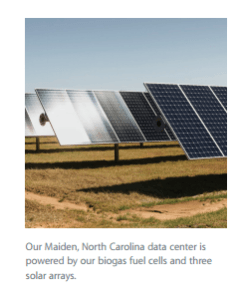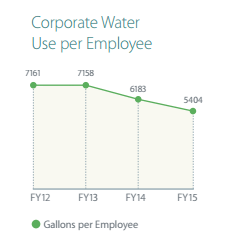Apple Reacts to and Leads in Climate Challenge
Apple has been a responsible technology giant in implementing socially and environmentally responsible business practices throughout its operation- from the deployment of clean energy to encourage efficient use of water, from maintaining high environmental standards for Apple itself to encouraging or enforcing environmental standards to its suppliers. It has truly been a leader in private sector which takes action in solving climate change challenges. It sets well as an example to the rest of the companies on the Fortune 500 list.
Apple Reacts to and Leads in Climate Challenge
Apple has been a responsible technology giant in implementing socially and environmentally responsible business practices throughout its operation- from the deployment of clean energy to encourage efficient use of water, from maintaining high environmental standards for Apple itself to encouraging or enforcing environmental standards to its suppliers. It has truly been a leader in private sector which takes action in solving climate change challenges. It sets well as an example to the rest of the companies on the Fortune 500 list.
In the 50-page Apple Environmental Responsibility Report[1], we not only see key words such as “social responsibility” but also begin to sense how Apple is spearheading the fight for climate change and grasp this global challenge as an opportunity to improve its energy use, product design (Exhibit 1), supply chain management, travel (Exhibit 2) and use of natural resources including water (Exhibit 3), paper and so forth. The strategy towards sustainability not only mirrors the brand image in the eyes of consumers but also sheds a light for Apple to become a next-generation Tech Giant with operational excellence and innovation mindset in long-term.
2015 marked one of the most significant years for climate change practitioners, as the world was watching the unveil of the United Nations Climate Summit in Paris. This was also the year that Apple showed its commitment and leadership in combating its carbon footprint- the deployment of solar in the U.S. operation, and later in China. But these were not the only actions Apple took regarding reducing carbon emissions. Under the leadership of Lisa Jackson, VP of Environmental Initiative and former Administrator of EPA, Apple approaches climate change in a systematic way:
By 2015, 93% of Apple’s facilities run on renewable energy[2] (Exhibit 4). In October 2015, Apple completed the construction on 40 megawatts of solar in West China which is enough to power 100% power use of Apple China’s operation. It made it possible for Apple to claim itself carbon neutral in one of its largest markets as well as the manufacturing sites in China. In addition, Apple also works with Foxconn, Apple’s largest manufacturing partner, to join its efforts and Foxconn committed 400 megawatts of solar by 2020 in the production of iPhones.
 Exhibit 4
Exhibit 4
In fact, even before China, Apple announced it would dedicate $848 million to California campus and retail stores, and another $2 billion to data centers in Arizona in early 2015[3]. On the one hand, these seem to be social responsibility; on the other hand, these investments help Apple manage operational risks of fluctuating power costs.
Through approximately $3 billion investment into renewable, Apple is emerging as a new player in the energy sector. In August 2016, Apple received regulatory permission to sell its excess energy to the market[4]. Although the regulation is approved on the condition that Apple’s energy supply to the market is small enough to not influence the market price, the approval may well enlighten Apple a new way of thinking about its future business and the future of its newly formed subsidiary, Apple Energy LLC [5][6].
Despite Apple has made much progress, it can do better. Apple has made its commitment in clean source of energy, and then the next natural step should be focusing its attention on how to use energy more efficiently, for example, installing LED light bulbs in 475 retail stores and corporate campus of Apple, and have Apple buildings LEED certified.
With the magnitude of capital investment into clean energy by Apple, the debate over who should be responsible for tackling climate change, how countries should adapt or mitigate the climate change, and what the role of private sector should be, becomes insignificant, as Tim Cooke, Apple’s CEO, said in an Apple Press Release, [7]” Climate change is one of the great challenges of our time, and the time for action is now.”
(637 words)
[1] Apple Environmental Responsibility Report 2016 http://images.apple.com/environment/pdf/Apple_Environmental_Responsibility_Report_2016.pdf
[2] Apple Environmental Responsibility Report 2016
http://images.apple.com/environment/pdf/Apple_Environmental_Responsibility_Report_2016.pdf
[3] Apple Goes Invest $3B into Solar Energy: http://www.triplepundit.com/2015/02/apple-goes-invest-3-billion-solar-energy/
[4] Solar Power From Apple Could Light Up Your Home http://fortune.com/2016/08/04/apple-approval-solar-electricity/
[5] Apple Can Now Sell Power as Tech Giants Boost Energy Investments
http://www.bloomberg.com/news/articles/2016-08-04/apple-can-now-sell-power-as-tech-giants-boost-energy-investments
[6] Why Apples New Energy Business Should Scare Utilities
https://www.greenbiz.com/article/why-apples-new-energy-business-should-scare-utilities
[7] Apple Launches New Clean Energy Programs in China: http://www.apple.com/pr/library/2015/10/22Apple-Launches-New-Clean-Energy-Programs-in-China-To-Promote-Low-Carbon-Manufacturing-and-Green-Growth.html






I didn’t think of Apple as a big polluter before. But this let me realize how much power they use in production and also retail. I wonder which part in Apple’s China operation is the solar power used for and whether that’s an efficient and sustainable energy solution from a cost perspective because as far as I know most of the solar companies (if not all) in China are losing money, some went bankrupt in the past few years and those survived still live on government’s subsidy. Basically if you exclude subsidy, then the more you produce the more money you lose. Electricity transmission is also a big problem in China. There is over production in electricity but not all can be transmitted through the gird as there’s a cap on that from the government. I hope transmitting the power out from West China to its operations across the country didn’t create Apple much problem..
I really appreciate the distinction that you drew between Apple entering the renewable space for the corporate social responsibility reasons, versus their drivers to mitigate exposure to volatile energy prices in multiple markets. I see Apple’s moves as much more the latter, given the fact that they are now past their prime as being the industries #1 product revolutionaries. The industry media and operators a-like have all but agreed: Tim Cook’s Apple looks eerily similar to Steve Ballmer’s Microsoft. Given, Apple has reached this same conclusion and no longer has confidence that they can win the design game, wouldn’t it make sense for them to reinvest their cash in other outlets that can give the appearance that the company is ‘moving forward’ and ‘pushing the limits’ as it was under Steve Jobs? I think the key difference here was that while under Jobs’ leadership, the limits that they were pushing were the core foundations of their market: consumer electronics. Without that core, Apple is heading down a dark and uncertain path.
https://www.technologyreview.com/s/602750/microsoft-is-looking-like-the-new-apple/
http://venturebeat.com/2016/10/25/why-tim-cook-is-steve-ballmer/